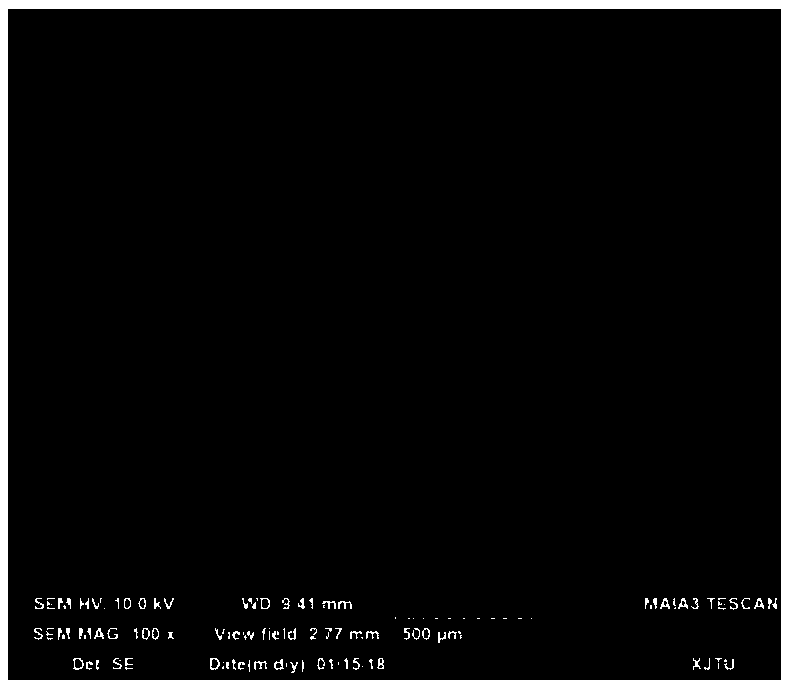Preparation method and application of oil-water separation net membrane
An oil-water separation mesh membrane, copper mesh technology, applied in separation methods, liquid separation, chemical instruments and methods, etc., can solve problems such as complex methods, harsh coating preparation conditions, and easy blocking of mesh holes, and achieve good application prospects. Effect
- Summary
- Abstract
- Description
- Claims
- Application Information
AI Technical Summary
Problems solved by technology
Method used
Image
Examples
Embodiment 1
[0030] 1) Clean the 400-mesh red copper mesh with ultrasonic in acetone, absolute ethanol and deionized water in sequence, and then clean it with dilute hydrochloric acid with a mass concentration of 3.65% to remove the surface oxide film. After cleaning, use N 2 blow dry;
[0031] 2) 1.69g AgNO 3 Dissolve in 500mL of deionized water to prepare AgNO 3 solution; take 0.2mL ammonia water drop by drop into 500mLAgNO 3 solution, and then place the solution in an ultrasonic cleaner for 200W ultrasonic dispersion for 5 minutes until completely dissolved to obtain a silver ammonia solution for use; wherein the ammonia water is a commercially available product with a mass concentration of 25% to 28%.
[0032] 3) Put the copper mesh treated in step 1) into the silver ammonia solution for 75 seconds and take it out to obtain a superhydrophilic / underwater superoleophobic mesh, and prepare the superhydrophilic / underwater superoleophobic mesh Dry in a constant temperature drying oven at...
Embodiment 2
[0036] 1) Clean the 400-mesh red copper mesh with ultrasonic in acetone, absolute ethanol and deionized water in sequence, and then clean it with dilute hydrochloric acid with a mass concentration of 3.65% to remove the surface oxide film. After cleaning, use N 2 blow dry;
[0037] 2) 1.69g AgNO 3 Dissolve in 500mL of deionized water to prepare AgNO 3 solution; take 0.2mL ammonia water dropwise into 500mL AgNO 3 solution, and then place the solution in an ultrasonic cleaner for 200W ultrasonic dispersion for 5 minutes until completely dissolved to obtain a silver ammonia solution for use;
[0038] 3) Put the copper mesh treated in step 1) into the silver ammonia solution for 75 seconds and take it out to obtain a superhydrophilic / underwater superoleophobic mesh, and prepare the superhydrophilic / underwater superoleophobic mesh Dry in a constant temperature drying oven at 90°C for 3 hours to obtain an oil-water separation omentum;
[0039] 4) Roll the sponge wrapped in the p...
Embodiment 3
[0042] 1) Clean the 400-mesh red copper mesh in acetone, absolute ethanol and deionized water in sequence, and then clean it with dilute hydrochloric acid with a mass concentration of 3.65% to remove the surface oxide film. After cleaning, use N 2 blow dry;
[0043] 2) 1.69g AgNO 3 Dissolve in 500mL of deionized water to prepare AgNO 3 solution; take 0.2mL ammonia water dropwise into 500mL AgNO 3 solution, and then place the solution in an ultrasonic cleaner for 200W ultrasonic dispersion for 5 minutes until completely dissolved to obtain a silver ammonia solution for use;
[0044]3) Put the copper mesh treated in step 1) into the silver ammonia solution for 75 seconds and take it out to obtain a superhydrophilic / underwater superoleophobic mesh, and prepare the superhydrophilic / underwater superoleophobic mesh Dry in a constant temperature drying oven at 90°C for 3 hours to obtain an oil-water separation omentum;
[0045] 4) Roll the sponge wrapped in the prepared oil-water...
PUM
| Property | Measurement | Unit |
|---|---|---|
| Concentration | aaaaa | aaaaa |
Abstract
Description
Claims
Application Information
 Login to View More
Login to View More - R&D Engineer
- R&D Manager
- IP Professional
- Industry Leading Data Capabilities
- Powerful AI technology
- Patent DNA Extraction
Browse by: Latest US Patents, China's latest patents, Technical Efficacy Thesaurus, Application Domain, Technology Topic, Popular Technical Reports.
© 2024 PatSnap. All rights reserved.Legal|Privacy policy|Modern Slavery Act Transparency Statement|Sitemap|About US| Contact US: help@patsnap.com










